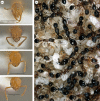Life-history evolution in ants: the case of Cardiocondyla
- PMID: 28298341
- PMCID: PMC5360909
- DOI: 10.1098/rspb.2016.1406
Life-history evolution in ants: the case of Cardiocondyla
Abstract
Ants are important components of most terrestrial habitats, and a better knowledge of the diversity of their life histories is essential to understand many aspects of ecosystem functioning. The myrmicine genus Cardiocondyla shows a wide range of colony structures, reproductive behaviours, queen and male lifespans, and habitat use. Reconstructing the evolutionary pathways of individual and social phenotypic traits suggests that the ancestral life history of Cardiocondyla was characterized by the presence of multiple, short-lived queens in small-sized colonies and a male polyphenism with winged dispersers and wingless fighters, which engage in lethal combat over female sexuals within their natal nests. Single queening, queen polyphenism, the loss of winged males and tolerance among wingless males appear to be derived traits that evolved with changes in nesting habits, colony size and the spread from tropical to seasonal environments. The aim of this review is to bring together the information on life-history evolution in Cardiocondyla and to highlight the suitability of this genus for functional genomic studies of adaptation, phenotypic plasticity, senescence, invasiveness and other key life-history traits of ants.
Keywords: Formicidae; alternative reproductive tactics; inbreeding; lethal fighting; male polyphenism; queen number.
© 2017 The Author(s).
Figures

Similar articles
-
Population and colony structure of an ant with territorial males, Cardiocondyla venustula.BMC Evol Biol. 2019 Jun 6;19(1):115. doi: 10.1186/s12862-019-1448-6. BMC Evol Biol. 2019. PMID: 31170910 Free PMC article.
-
Interruption points in the wing gene regulatory network underlying wing polyphenism evolved independently in male and female morphs in Cardiocondyla ants.J Exp Zool B Mol Dev Evol. 2019 Jan;332(1-2):7-16. doi: 10.1002/jez.b.22834. Epub 2018 Nov 20. J Exp Zool B Mol Dev Evol. 2019. PMID: 30460750
-
The evolution of alternative reproductive tactics in male cardiocondyla ants.Evolution. 2010 Nov;64(11):3310-7. doi: 10.1111/j.1558-5646.2010.01090.x. Evolution. 2010. PMID: 20666842
-
Caste development and evolution in ants: it's all about size.J Exp Biol. 2017 Jan 1;220(Pt 1):53-62. doi: 10.1242/jeb.145292. J Exp Biol. 2017. PMID: 28057828 Review.
-
The plasticity of lifespan in social insects.Philos Trans R Soc Lond B Biol Sci. 2021 Apr 26;376(1823):20190734. doi: 10.1098/rstb.2019.0734. Epub 2021 Mar 8. Philos Trans R Soc Lond B Biol Sci. 2021. PMID: 33678025 Free PMC article. Review.
Cited by
-
The interactions of ants with their biotic environment.Proc Biol Sci. 2017 Mar 15;284(1850):20170013. doi: 10.1098/rspb.2017.0013. Proc Biol Sci. 2017. PMID: 28298352 Free PMC article. Review.
-
Methuselah's daughters: Paternal age has little effect on offspring number and quality in Cardiocondyla ants.Ecol Evol. 2018 Nov 8;8(23):12066-12072. doi: 10.1002/ece3.4666. eCollection 2018 Dec. Ecol Evol. 2018. PMID: 30598800 Free PMC article.
-
Trade-offs between immunity and competitive ability in fighting ant males.BMC Ecol Evol. 2023 Aug 7;23(1):37. doi: 10.1186/s12862-023-02137-7. BMC Ecol Evol. 2023. PMID: 37550612 Free PMC article.
-
Queens stay, workers leave: caste-specific responses to fatal infections in an ant.BMC Evol Biol. 2018 Dec 27;18(1):202. doi: 10.1186/s12862-018-1320-0. BMC Evol Biol. 2018. PMID: 30587108 Free PMC article.
-
Convergent evolution of a labile nutritional symbiosis in ants.ISME J. 2022 Sep;16(9):2114-2122. doi: 10.1038/s41396-022-01256-1. Epub 2022 Jun 14. ISME J. 2022. PMID: 35701539 Free PMC article.
References
-
- Jervis MA, Heimpel GE, Ferns PN, Harvey JA, Kidd NC. 2001. Life-history strategies in parasitoid wasps: a comparative analysis of ‘ovigeny’. J. Anim. Ecol. 40, 442–458. (10.1046/j.1365-2656.2001.00507.x) - DOI
-
- Promislow DEL, Harvey PH. 1990. Living fast and dying young: a comparative analysis of life-history variation among mammals. J. Zool. 220, 417–437. (10.1111/j.1469-7998.1990.tb04316.x) - DOI
-
- Seifert B. 2002. The ant genus Cardiocondyla (Insecta: Hymenoptera: Formicidae): a taxonomic revision of the C. elegans, C. bulgarica, C. batesii, C. nuda, C. shuckardi, C. stambuloffii, C. wroughtonii, C. emeryi, and C. minutior species groups. Ann. Naturhist. Mus. Wien 104B, 203–338.
Publication types
MeSH terms
LinkOut - more resources
Full Text Sources
Other Literature Sources

